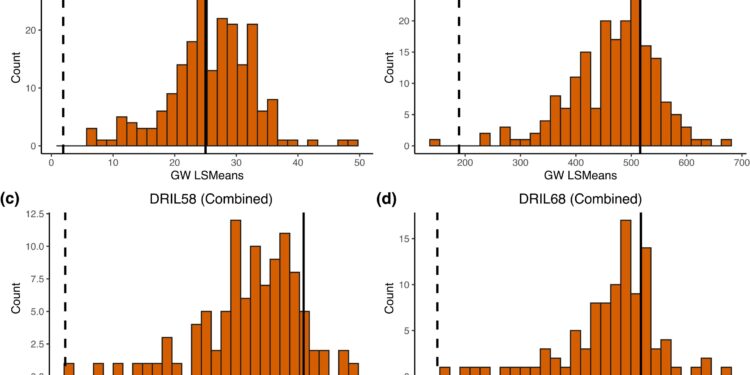Phenotypic distribution of GW in the 3 populations. For the DRIL58 and DRIL68 populations, combined estimates of the environmental LsMeans for the AUDPC of the GW data are presented. For the DRIL38 population, there was only one rating in 2018 and no AUDPC calculated. Thus, the distribution of the DRIL38 2018 estimate was not combined with the DRIL38 2019 estimate which was based on the AUDPC calculated from 3 ratings. The solid line indicates the LsMean of the common recurrent parent Oh7B and the dotted lines indicate the LsMeans of the donor parents, which is different for each population. The donor line for the DRIL38 population is Ki3; for population DRIL58 is NC262 and for population DRIL68 is NC304. Credit: G3: Genes, Genomes, Genetics (2023). DOI: 10.1093/g3journal/jkad275
In a changing climate, corn growers must be prepared for anything, including evolving diseases. Since it is impossible to predict which harmful disease will appear in any given year, multi-disease resistant corn would be a huge win for growers. Now, University of Illinois Urbana-Champaign researchers are moving the industry closer to that goal.
Goss’s wilt, a bacterial disease, and fungal diseases, gray leaf spot, northern corn leaf blight, and southern corn leaf blight are important to growers in the Midwestern United States and, in some cases, from all over the world. The study, published in G3: Genes, Genomes, Geneticsreveals genomic regions associated with resistance to four diseases.
“We not only discovered regions of the genome conferring resistance to each disease, but we also identified a handful of experimental corn lines resistant to all of them. These findings should help the industry develop materials resistant to multiple diseases at the same time. times,” Tiffany said. Jamann, lead author of the new study and associate professor in the Department of Crop Sciences, part of U of I’s College of Agricultural, Consumer and Environmental Sciences (ACES).
The team made several strategic crosses between disease-resistant and susceptible corn lines, which allowed them to map resistance traits to specific locations in the genome. Currently, these regions are quite large and include hundreds of individual genes. If there are specific genes with outsized effects, they have not yet been identified.
However, it is still useful to identify important regions, because disease resistance is rarely reduced to a single gene. In fact, the additive or quantitative power of multiple genes working together can result in more durable resistance. There is a fallback if a pathogen manages to bypass a given resistance mechanism. Interestingly, this durability can even work against different groups of pathogens.
“We found 19 regions associated with resistance to bacterial Goss’ wilt disease. Several of these regions are also involved in resistance to fungal pathogens,” Jamann said. “Thus, it is possible to create resistance to multiple diseases simultaneously using the same genetic regions.”
Fungi and bacteria are very different biologically, but both must find a way to enter the plant, move around and reproduce. Jamann says it’s possible that resistance genes trigger changes in the plant’s vascular system to make it harder for both types of pathogens to move around, but she still can’t say exactly how the genes help plants to protect themselves. She’s working on it, though, thanks to a 2022 grant from the National Science Foundation.
Although the team identified three corn lines resistant to all four diseases, it will be some time before growers can purchase multi-resistant corn seeds through this work. First, Jamann’s team will fine-map the regions highlighted in this study to find the major effect genes, then transmit this information to breeders who can develop robust new hybrids. Yet, says Jamann, multiple resistances are on the way.
More information:
Yuting Qiu et al, Identification of loci conferring resistance to 4 corn foliar diseases, G3: Genes, Genomes, Genetics (2023). DOI: 10.1093/g3journal/jkad275
Provided by University of Illinois at Urbana-Champaign
Quote: Study reveals corn genome can attack multiple pathogens simultaneously (February 7, 2024) retrieved February 7, 2024 from
This document is subject to copyright. Apart from fair use for private study or research purposes, no part may be reproduced without written permission. The content is provided for information only.



